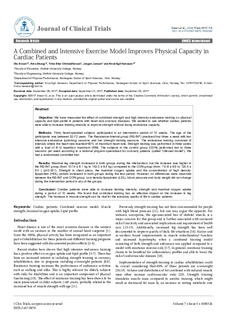| dc.contributor.author | Sveen, Ole | |
| dc.contributor.author | Skaug, Arne | |
| dc.contributor.author | Hanssen, Knut Egil | |
| dc.contributor.author | Jensen, Jørgen | |
| dc.contributor.author | Christoffersen, Trine Eker | |
| dc.date.accessioned | 2018-04-11T11:11:56Z | |
| dc.date.available | 2018-04-11T11:11:56Z | |
| dc.date.created | 2017-11-24T10:10:57Z | |
| dc.date.issued | 2017 | |
| dc.identifier.citation | Journal of Clinical Trials. 2017, 7, 326. | |
| dc.identifier.issn | 2167-0870 | |
| dc.identifier.uri | http://hdl.handle.net/11250/2493630 | |
| dc.description | This is an open-access article distributed under the terms of the Creative Commons Attribution License, which permits unrestricted use, distribution, and reproduction in any medium, provided the original author and source are credited. | |
| dc.description.abstract | Objective: We have measured the effect of combined strength and high intensity endurance training on physical capacity and lipid profile in patients with heart and coronary diseases. We wanted to see whether cardiac patients were able to increase training intensity to improve strength without losing endurance capacity.
Methods: Thirty heart-operated subjects participated in an intervention period of 10 weeks. The age of the participants was between 52-72 years. The Resistance-Interval group (RE-INT) practiced four times a week with two intensive endurance (spinning) sessions and two strength training sessions. The endurance training consisted of intervals where the heart rate reached>90% of maximum heart rate. Strength training was performed in three series with a load of 8-12 repetition maximum (RM). The subjects in the control group (CON) performed two to three sessions per week according to a national program specialized for coronary patients (called “Ullevaal model”). We had a randomized controlled trial.
Results: Maximal leg strength increased in both groups during the intervention, but the increase was higher in the RE-INT group (from 107.9 ± 8.1 kg to 162.0 ± 8.4 kg) compared to the CON group (from 110.8 ± 8.9 to 125.4 ± 9.5 ) (p<0.001). Strength in chest press, the maximal oxygen uptake and the concentration of high densitylipoprotein (HDL) protein increased in both groups during the test period. However, no differences were observed between the RE-INT and CON group. Low density-lipoprotein (LDL), blood pressure and body weight did not change during the intervention period in any of the groups.
Conclusion: cardiac patients were able to increase training intensity, strength and maximal oxygen uptake during a period of 10 weeks. We found that combined training has an effective impact on the increase in leg strength. The increase in muscle strength can be vital for the everyday quality of life in cardiac patients. | |
| dc.language.iso | eng | |
| dc.subject | cardiac patients | |
| dc.subject | combined exercise model | |
| dc.subject | muscle strength | |
| dc.subject | maximal oxygen uptake | |
| dc.subject | lipid profile | |
| dc.title | A combined and intensive exercise model improves physical capacity in cardiac patients | |
| dc.type | Peer reviewed | |
| dc.type | Journal article | |
| dc.description.version | acceptedVersion | |
| dc.rights.holder | © 2017 Sveen O, et al. | |
| dc.source.pagenumber | 6 | |
| dc.source.volume | 7 | |
| dc.source.journal | Journal of Clinical Trials | |
| dc.source.issue | 5 | |
| dc.identifier.doi | 10.4172/2167-0870.1000326 | |
| dc.identifier.cristin | 1518026 | |
| dc.description.localcode | Seksjon for fysisk prestasjonsevne / Department of Physical Performance | |
| cristin.unitcode | 150,31,0,0 | |
| cristin.unitname | Seksjon for fysisk prestasjonsevne | |
| cristin.ispublished | true | |
| cristin.fulltext | postprint | |
| cristin.qualitycode | 1 | |
